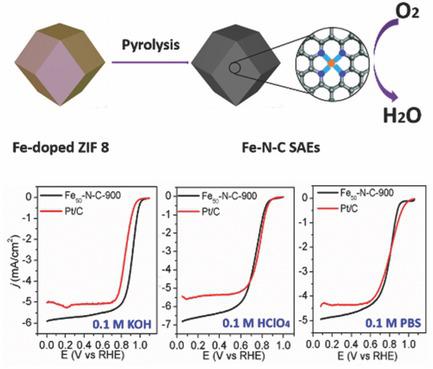Our official English website, www.x-mol.net, welcomes your
feedback! (Note: you will need to create a separate account there.)
Porous Carbon‐Hosted Atomically Dispersed Iron–Nitrogen Moiety as Enhanced Electrocatalysts for Oxygen Reduction Reaction in a Wide Range of pH
Small ( IF 13.0 ) Pub Date : 2018-02-12 , DOI: 10.1002/smll.201703118 Shaofang Fu 1 , Chengzhou Zhu 1, 2 , Dong Su 3 , Junhua Song 1 , Siyu Yao 4 , Shuo Feng 1 , Mark H. Engelhard 5 , Dan Du 1, 2 , Yuehe Lin 1
Small ( IF 13.0 ) Pub Date : 2018-02-12 , DOI: 10.1002/smll.201703118 Shaofang Fu 1 , Chengzhou Zhu 1, 2 , Dong Su 3 , Junhua Song 1 , Siyu Yao 4 , Shuo Feng 1 , Mark H. Engelhard 5 , Dan Du 1, 2 , Yuehe Lin 1
Affiliation

|
As one of the alternatives to replace precious metal catalysts, transition‐metal–nitrogen–carbon (M–N–C) electrocatalysts have attracted great research interest due to their low cost and good catalytic activities. Despite nanostructured M–N–C catalysts can achieve good electrochemical performances, they are vulnerable to aggregation and insufficient catalytic sites upon continuous catalytic reaction. In this work, metal–organic frameworks derived porous single‐atom electrocatalysts (SAEs) were successfully prepared by simple pyrolysis procedure without any further posttreatment. Combining the X‐ray absorption near‐edge spectroscopy and electrochemical measurements, the SAEs have been identified with superior oxygen reduction reaction (ORR) activity and stability compared with Pt/C catalysts in alkaline condition. More impressively, the SAEs also show excellent ORR electrocatalytic performance in both acid and neutral media. This study of nonprecious catalysts provides new insights on nanoengineering catalytically active sites and porous structures for nonprecious metal ORR catalysis in a wide range of pH.
中文翻译:

多孔碳基原子分散的铁-氮部分作为在宽pH范围内进行氧还原反应的增强电催化剂
作为替代贵金属催化剂的替代方法之一,过渡金属-氮-碳(MC)催化剂因其低成本和良好的催化活性而引起了极大的研究兴趣。尽管纳米结构的M–N–C催化剂可以实现良好的电化学性能,但在连续的催化反应中,它们易于聚集并且催化位点不足。在这项工作中,通过简单的热解程序成功地制备了由金属-有机骨架衍生的多孔单原子电催化剂(SAE),而无需进行任何进一步的后处理。结合X射线吸收近边缘光谱法和电化学测量,与碱性条件下的Pt / C催化剂相比,SAE具有更好的氧还原反应(ORR)活性和稳定性。更令人印象深刻的是 SAE在酸性和中性介质中也显示出优异的ORR电催化性能。这项对非贵金属催化剂的研究为在广泛的pH值范围内对非贵金属ORR催化的纳米工程催化活性位和多孔结构提供了新的见解。
更新日期:2018-02-12
中文翻译:

多孔碳基原子分散的铁-氮部分作为在宽pH范围内进行氧还原反应的增强电催化剂
作为替代贵金属催化剂的替代方法之一,过渡金属-氮-碳(MC)催化剂因其低成本和良好的催化活性而引起了极大的研究兴趣。尽管纳米结构的M–N–C催化剂可以实现良好的电化学性能,但在连续的催化反应中,它们易于聚集并且催化位点不足。在这项工作中,通过简单的热解程序成功地制备了由金属-有机骨架衍生的多孔单原子电催化剂(SAE),而无需进行任何进一步的后处理。结合X射线吸收近边缘光谱法和电化学测量,与碱性条件下的Pt / C催化剂相比,SAE具有更好的氧还原反应(ORR)活性和稳定性。更令人印象深刻的是 SAE在酸性和中性介质中也显示出优异的ORR电催化性能。这项对非贵金属催化剂的研究为在广泛的pH值范围内对非贵金属ORR催化的纳米工程催化活性位和多孔结构提供了新的见解。











































 京公网安备 11010802027423号
京公网安备 11010802027423号